Management
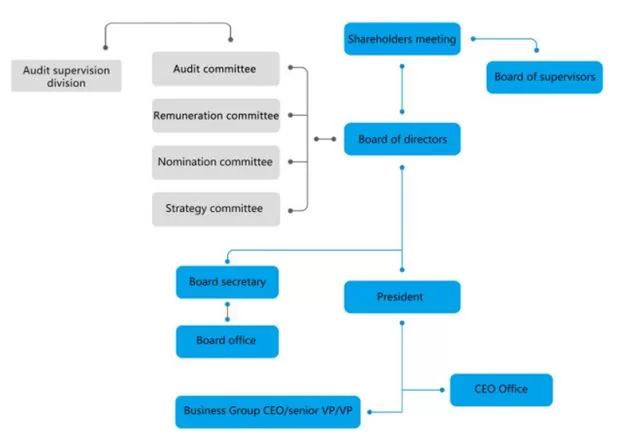
BYD organizational structure has the following characteristics: – Matrix Structure. BYD corporate structure is matrix, combining functional departments (e.g., R&D, Sales) with product-based divisions (e.g., Dynasty, Ocean, Commercial Vehicles). This fosters collaboration and flexibility while maintaining focus on specific product lines. The matrix structure enables quick decision-making and adjustments to market dynamics – Independent Brands. Recent moves towards independent operations for brands like Dynasty and Ocean indicate a strategy to cater to distinct market segments with tailored brand identities and marketing efforts. In other words, independent brands allow for targeted approaches. – Emphasis in R&D. BYD prioritizes internal R&D, with dedicated institutes for each brand and separate units for core technologies like DM-i hybrids and intelligent driving. This fosters innovation and control over key components. – Vertical Integration. The EV behemoth vertically integrates key aspects of its supply chain, including battery production and some vehicle components. Such an approach enhances cost control and quality assurance. Vertical integration expands BYD organizational structure. – Regional Variations. The electric automaker’s structure adjusts to regional needs, with separate sales divisions and local leadership teams managing specific markets. Regular variations approach ensures responsiveness to diverse customer preferences and regulations. The Figure below illustrates BYD corporate structure at the senior level. BYD Company Limited Organizational Chart BYD Company Limited Report contains the above analysis of BYD organizational structure. The report illustrates the application of the major analytical strategic frameworks in business studies such as SWOT, PESTEL, Porter’s Five Forces, Value Chain analysis, Ansoff Matrix and McKinsey 7S Model on BYD. Moreover, the report contains analyses of BYD leadership, business strategy and organizational culture. The report also comprises discussions of BYD marketing strategy, ecosystem and addresses issues of corporate social responsibility.

Marriott organizational structure had to change significantly with new executive appointments early in 2023. Following the departure of company’s president Stephanie Linnartz to become president and CEO of Baltimore-based sports equipment company Under Armour, Anthony Capuano became Marriott’s President and CEO[1]. Marriott International has a hybrid organizational structure that combines elements of both a matrix and functional structure. The company’s matrix structure is evident in the combination of functional and divisional configurations. Marriott has functional divisions such as marketing, sales, and operations, but it also has divisional units organized by geographic region. This allows the largest hotel chain in the world to achieve both global uniformity and local diversification and responsiveness. Marriott Organizational Structure The matrix structure works in conjunction with a regional structure, with each region having its own functional divisions. For example, the Greater China region has its own marketing, sales, and operations divisions. This allows Marriott to tailor its operations to the specific needs of each region. Marriott’s organizational structure is also characterized by a high degree of centralization. The company’s CEO and executive team have a significant amount of authority over decision-making. This centralization allows Marriott to maintain a consistent brand image and service quality across all of its properties. Marriott International’s hybrid organizational structure has several advantages. The matrix structure allows the company to achieve both global uniformity and local diversification and responsiveness. The regional structure allows the hotel chain to tailor its operations to the specific needs of each region. The centralization of authority allows the company to maintain a consistent brand image and service quality across all of its properties. However, there are also some potential disadvantages to Marriott organizational structure. The matrix structure can be complex and time-consuming, and it can lead to conflict between functional and divisional units. The centralization…
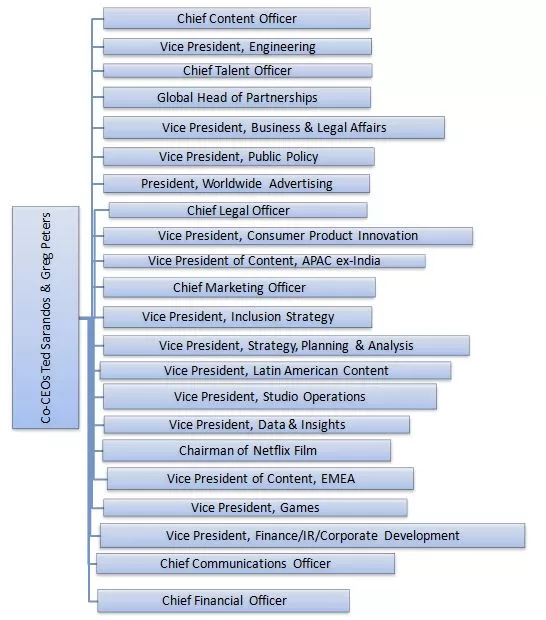
Netflix organizational structure can be classified as relatively flat. This is an unconventional for a multinational giant that employs more than 12500 people in offices in over 25 countries[1]. Fewer management layers increases the span of control for each manager. Corporate structure of Netflix can also be described as unitary or u-form. In companies with unitary structure the business is managed as a single unit and it has functional lines such as sales, marketing, engineering etc. Flat and unitary aspects of corporate culture of Netflix offers a range of advantages for the the entertainment services provider. Specifically, less hierarchy ensures faster and better communication among employees at all levels, thus increasing the speed and quality of decision making. This is critically important taking into account increasingly dynamic nature of the external marketplace and the need for the company to adapt quickly. Netflix organizational structure had to change early in 2023 when co-founder Reed Hastings stepped down from the role of CEO. Nevertheless, the flat and unitary nature of the organizational structure has remained. Moreover, even though Reed Hastings is no longer CEO of the on-demand media provider, he remains as the ultimate decision maker on the strategic issues. This arrangement may prove to be practically helpful whenever there is a disagreement between current co-CEOs Ted Sarandos and Greg Peters. Netflix Organizational Structure Netflix Inc. Report contains the above analysis of Netflix organizational structure. The report illustrates the application of the major analytical strategic frameworks in business studies such as SWOT, PESTEL, Porter’s Five Forces, Value Chain analysis, Ansoff Matrix and McKinsey 7S Model on Netflix. Moreover, the report contains analyses of Netflix leadership, business strategy and organizational culture. The report also comprises discussions of Netflix marketing strategy, ecosystem and addresses issues of corporate social responsibility. [1] ESG Report (2022)…
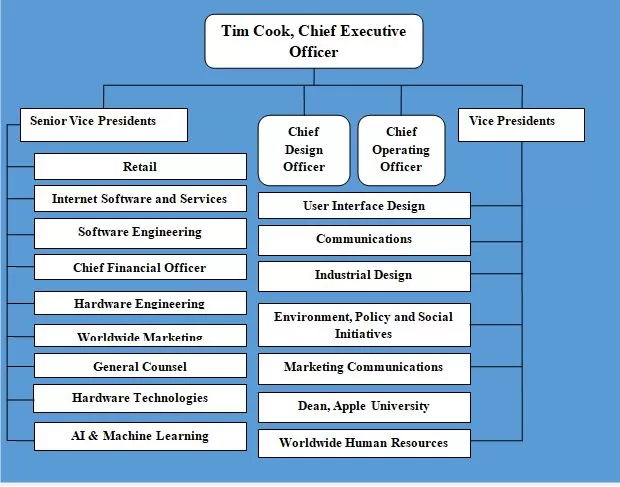
Apple organizational structure can be described as hierarchical and functional. Such a structure has been developed by its founder and former CEO late Steve Jobs in order to ensure focused realization of his innovative ideas and clear vision for the business. When Steve Jobs returned to turnaround failing Apple in 1997 the company had a typical organizational structure with many business units with their own profit and loss (P&L) responsibilities. In order to increase the coherence and fuel innovation, Jobs fired general managers of all business units (within one day) and put in place one P&L for the entire business. Apple organizational structure has been subjected to certain modifications since the leadership role was assumed by Tim Cook on August 2011. Specifically, Mr. Cook embraced the decentralization of decision making to a certain extent in order to encourage innovation and creativity at various levels. Also, Cook divided hardware function into hardware engineering and hardware technologies. As the most recent change to the corporate structure Cook added artificial intelligence (AI) and machine learning as separate function areas due the increasing importance of AI and machine learning. Currently, Apple organizational structure has the format illustrated in figure below: Apple Organizational Structure Generally, Apple corporate structure has the following characteristics: 1. Hierarchical organizational structure. Although Tim Cook introduced considerable changes to Apple corporate structure since assuming the top job in 2011, the structure still remains to be highly hierarchical with many layers of management. Massive size of the company that comprises 164,000 full-time equivalent employees globally necessitates the adherence to the hierarchical organisational structure. Advantages of Apple hierarchical organizational structure include tight control possessed by senior management over all aspects of the business. Moreover, promotion opportunities motivate employees to perform well and there are clear levels of authority and responsibility. On the negative…
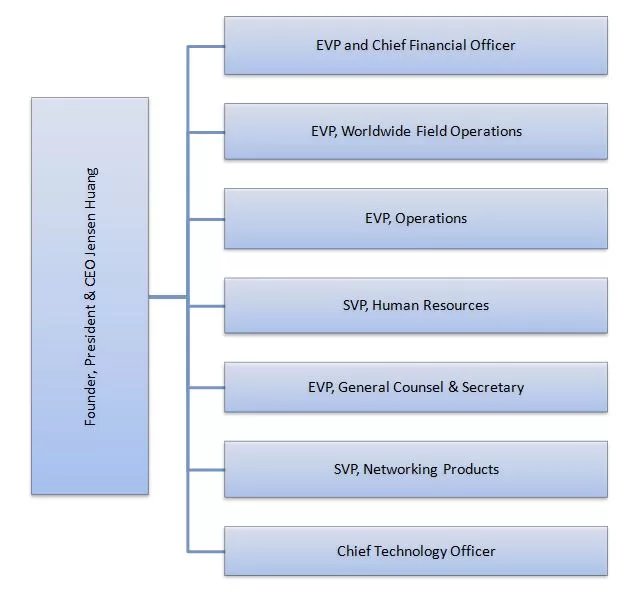
Nvidia is 7th largest company in the world with a market cap of USD 1 trillion. Due to the size and scope of its operations, it is difficult to categorise Nvidia organizational structure within a certain group. However, it is evident that the tech company uses certain elements of functional and hybrid organizational structure. The multinational technology company divides its business practices into various functions such as engineering and product development, supply chain and operations, human resources, finance and accounting and legal and compliance. Functional organizational structure provides a range of advantages for Nvidia. Specifically, employees are assigned into groups on the basis of their competencies and expertise. This allows the groups to achieve their goals with high level of efficiency. Furthermore, functional organizational structure is associated with clear reporting lines and this can enhance the speed and quality of decision making at Nvidia. Nvidia also has certain components of matrix organizational structure in place. Temporary product or project groups are often formed within the multinational technology company and group members report to both, group leader, as well as their direct superiors within the organizational structure. The figure below illustrates the corporate structure of Nvidia: Nvidia Organizational Structure Nvidia Corporation Report contains the above analysis of Nvidia organizational structure. The report illustrates the application of the major analytical strategic frameworks in business studies such as SWOT, PESTEL, Porter’s Five Forces, Value Chain analysis, Ansoff Matrix and McKinsey 7S Model on Nvidia. Moreover, the report contains analyses of Nvidia leadership, business strategy and organizational culture. The report also comprises discussions of Nvidia marketing strategy, ecosystem and addresses issues of corporate social responsibility.

Under the leadership of co-founder and former CEO Adam Neumann WeWork organizational structure was complex. Figure 1 below is a ‘simplified’ version of WeWork organizational structure the company submitted for IPO Prospectus on August 2019. The structure fails to clearly illustrate the organization of the business from the viewpoint of who reports to whom. It also fails to clearly indicate the flow of information, an essential component of a good organizational structure. Figure 1 We Work organizational structure under Adam Neumann If this is a ‘simplified’ version, it would be safe to assume that the original version would be much more difficult to comprehend. Ineffective organizational structure is one of the main reasons why global flexible workspace provider faced near bankruptcy in 2019. After the departure of Adam Neumann, the new CEO Sandeep Mathrani restructured the business simplifying the organizational structure to a great extend with a clear pattern for information flow. Figure 2 Current pattern of WeWork organizational structure Organizational structure of WeWork can be classified as hierarchical. Such a structure offers advantages to the co-working giant such as creating a landscape for Sandeep Mathrani to turn around the business to make it suitable for long-term. Hierarchical structure offers clear delegation of authority and encourages specialization among employees at all levels. On the negative side, hierarchy can cause rivalries between various departments. It can also slow down the implementation of proposed changes through loss or misinterpretation of information along the hierarchy. The current organizational structure of WeWork may change in the foreseeable future because the structural changes by Mathrani are far from complete. Mathrani has predicted flexi-working revolution at a global scale[1] and he is striving WeWork to lead such a revolution. WeWork Inc. Report contains the above analysis of WeWork organizational structure. The report illustrates the…

Organizational structure can be defined as a system for outlining management roles and responsibilities to achieve organizational goals. Organizational structure also determines the pattern of information flow within the organization. For instance, in highly hierarchical structures decisions are communicated from top to down, whereas in flat structures the power for decision making is distributed among various levels. Organizational structure aims to provide efficiency and focus to operations. Appropriate structure should illustrate how the roles and responsibilities of each employee fit within the overall system. Organizational structure has the following four main elements: Chain of command. Illustrating who reports to whom via an organizational chart. Defining departments. Clustering tasks, roles and responsibilities into groups and defining connections between various groups. Extend of control. Categorizing each and every task into departments to avoid a situation where two or more people do the same task. Centralization. Identifying the levels where decisions are made. There are four main types of organizational structures – functional, divisional, flat and matrix. Functional Structure Functional structure is based on specialization of employees and it is the most common organizational structure. It is also referred to as bureaucratic structure and divides company into various departments such as procurement, operations, marketing , finance etc. Divisional Structure Divisional structure is also popular and it divides to company into various divisions on the basis of products, projects or subsidiaries. Flat Structure Flat structure, also referred to as horizontal structure aims to minimize the chain of command providing employees with autonomy in decision making. This pattern is popular among startups. Matrix Organizational Structure Matrix structure is the most complex and accordingly, the least popular. Matrix structure assigns employees across various divisions and supervisors. Employees in such a structure may belong to more than one divisions and report to several superiors. In this portal…
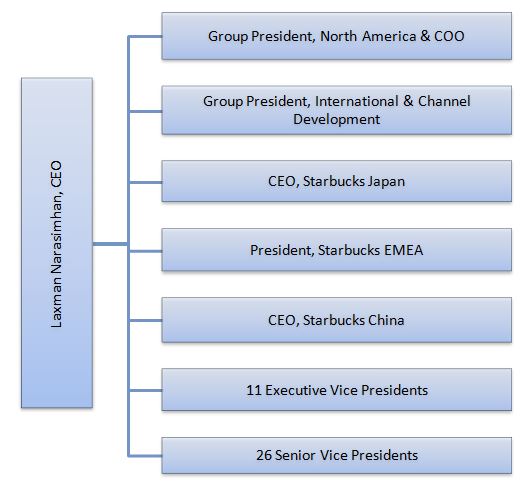
Starbucks corporate structure sustains international scope of its business operations that encompasses more than 34000 stores in 84 markets. Starbucks organizational structure is hybrid and integrates geographic, brand-based and functional hierarchy structures. Organizational structure of Starbucks can be divided into the following divisions: 1. Geographic divisions. Starbucks operations are divided into the following geographic divisions or segments: a) North America division. This division consists of USA and Canada b) International division consisting of China, Japan, Asia Pacific, Europe, Middle East, Africa, Latin America and Caribbean 2. Brand-based divisions. Each brand within Starbucks Corporation portfolio represents a separate division led by the head of division. The world’s largest coffeehouse chain has brand-based divisions as illustrated in table below: Brand Founded Products Starbucks 1971 Coffee, non-alcoholic beverages, food Teavana® 1997 Variety of teas La Boulange® 1999 French pastries and breads Evolution Fresh™ 1992 Nourishment juices and foods Seattle’s Best Coffee 1991 Coffee, non-alcoholic beverages, food Tazo Tea 1994 Teas, herbs, roots and spices Brand-based divisions within Starbucks organizational structure Starbucks corporate structure is functional hierarchy and accordingly, groups are formed according to business functions on Executive Vice President (EVP) and Senior Vice President (SVP) levels. Specifically, as illustrated in figure below organizational structure of Starbucks includes 11 Executive Vice Presidents each leading a separate function below: Chief Financial Officer Chief Marketing Officer Chief Strategy & Transformation Officer Global Coffee, Tea and Cocoa Global Supply Chain Chief Technology Officer Public Affairs Chief Partner Officer Global Channel Development Starbucks North America General Counsel Starbucks Organizational Structure Similarly, there are 24 functions headed by 26 executives at Senior Vice Presidents level: Store Development Ethics and Compliance officer Chief Procurement Officer, Global Sourcing Product Experience Global Chief Inclusion and Diversity Officer Starbucks Canada Americas Finance Latin America & Caribbean Partner…
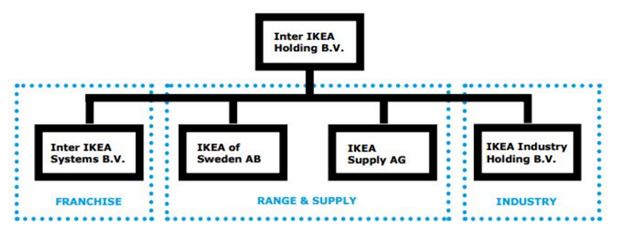
IKEA has a unique organizational structure. Specifically, “around the globe, a large number of companies operate under the IKEA trademarks. All IKEA franchisees are independent of Inter IKEA Group. A large group of franchisees are owned and operated by INGKA Group. Inter IKEA Group and INGKA Group have the same founder, and a common history and heritage, but have operated under different owners and management since the 1980s”[1] Figure 1 below illustrates the essence of IKEA organizational structure: Figure 1 IKEA organizational structure Inter IKEA Group integrates of a group of companies. The group sets strategic direction for the whole business and connects all IKEA franchisee. The group is formed of three core businesses as illustrated in Figure 1 above: 1. Inter IKEA Systems B.V. is the furniture retailer’s franchisor worldwide. This unit also deals with franchise agreements with 11 franchisees that operate in more than 500 locations.[2] 2. IKEA Range & Supply develops and supplies products for the home improvement and furnishing chain. 3. IKEA Industry produces home furnishing products and it manufactures about 10-12% of the total range. The present organizational structure of IKEA illustrated in Figure 1 above is the outcome of a major restructuring initiative that was introduced in 2016. To improve the franchise system and clarify roles, IKEA range, supply and production activities were transferred to the new Inter IKEA Group headed by Inter IKEA Holding B.V. Currently, Jon Abrahamsson Ring is the CEO of Inter IKEA Holding B.V. The Figure 2 below illustrates the overview of the franchise system. Figure 2 Overview of the IKEA franchise system[3] Specifically, IKEA Group sold key subsidiaries for EUR 5.2 billion to increase the flexibility of the business to be able to adapt to changes in the external global marketplace. IKEA management considers this change to be much…

McDonald’s organizational structure can be classified as divisional. McDonald’s business operations are divided into the following four divisions according to their geographical location: United States Europe Asia/Pacific, Middle East and Africa (“APMEA”) Other countries Each division above possesses its own departments such as IT, finance, marketing and others. Massive changes in McDonald’s organizational structure introduced in 2015 increased the emphasis on the international markets clarifying the roles of executives responsible for growth in international markets. Specifically, as it is illustrated in Figure 1 below, the responsibility for overseeing international operations is distributed among three senior executives at President level. Figure 1 McDonald’s leadership structure in international markets[1] Presidents are provided autonomy in decision making to a great extent to increase sales in their respective markets. The autonomy refers to adjusting the content and delivery McDonald’s marketing message to their respective markets taking into account cross-cultural differences. Moreover, Presidents are free to introduce new items in menu reflecting tastes and preferences of local markets. Furthermore, from administrative point of view McDonald’s organizational structure involves nine senior level managers reporting to President and CEO Chris Kempczinski. These managers include Vice President and Executive Vice Presidents and each manager is responsible for a specific strategic aspect of the business. Figure 2 McDonald’s organizational structure Since becoming President and CEO in 2019 Mr. Chris Kempczinski did not introduce any massive changes in McDonald’s corporate structure. However, he may restructure the business to a certain extent to reflect changes in the external environment. Specifically, COVID 19 pandemic revealed the importance of delivery and McDonald’s may change its corporate structure to ensure greater focus on making deliveries to homes and offices. McDonald’s Corporation Report contains the above analysis of McDonald’s organizational structure. The report illustrates the application of the major analytical strategic frameworks…
